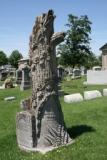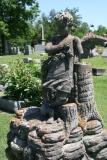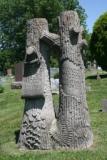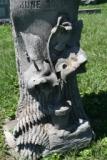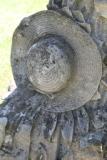TombstonesTraipsing across the hills and hollers of Southern Indiana in pursuit of log buildings, Warren became enamored of the carved limestone monuments in the form of tree-stumps that he encountered in the area’s cemeteries. His original interest was the tools on the tombstones, used to depict in a symbolic way the trade that the deceased had followed in his or her lifetime. He came to recognize that these evocative tombstones conveyed, at once, deeply personal emotion and broad-based community acceptance and admiration—all of which he insisted is critical to defining folk art. "When the [Indiana limestone] industry was still flourishing, the local mills employed great numbers of stone-carvers to produce the carved work that adorned buildings. . . . But on occasion, in their spare time or in between jobs, they could turn their skills and knowledge to making items basically of their own designs. . . ." "When asked what the monuments were called, Mrs. Bennett [the wife of carver Newman Bennett] replied, 'I think you just called them tree stumps—he’d come home and say, ‘I sold a stump job today.’ Asked if carving was a creative talent, an art, Mrs. Bennett said, 'I guess it is an art. I never thought about it that way. I was always surrounded by stone people. . . . When you are raised on it, you don’t think about anyone else being interested in it.' As we might expect, she stressed the skills needed rather than the creative talent of the carver. 'A stonecutter knows where every tool he has is and where to use it. You’d be surprised what you can do with a piece of stone. When they start out, it looks like a big hunk of nothing.' When asked if there was anything her husband emphasized about his work, she said, 'He liked deep letters; said they lasted longer that way. He didn’t think Jess [his brother] made them deep enough.'” Warren Roberts, “Investigating the Tree-Stump Tombstone,” in American Material Culture and Folklife: A Prologue and Dialogue, 137, 141.
Here are some photos taken by Patricia Glushko in the Green Hills Cemetery in Bedford, on a sunny June 1, 2011:
|



